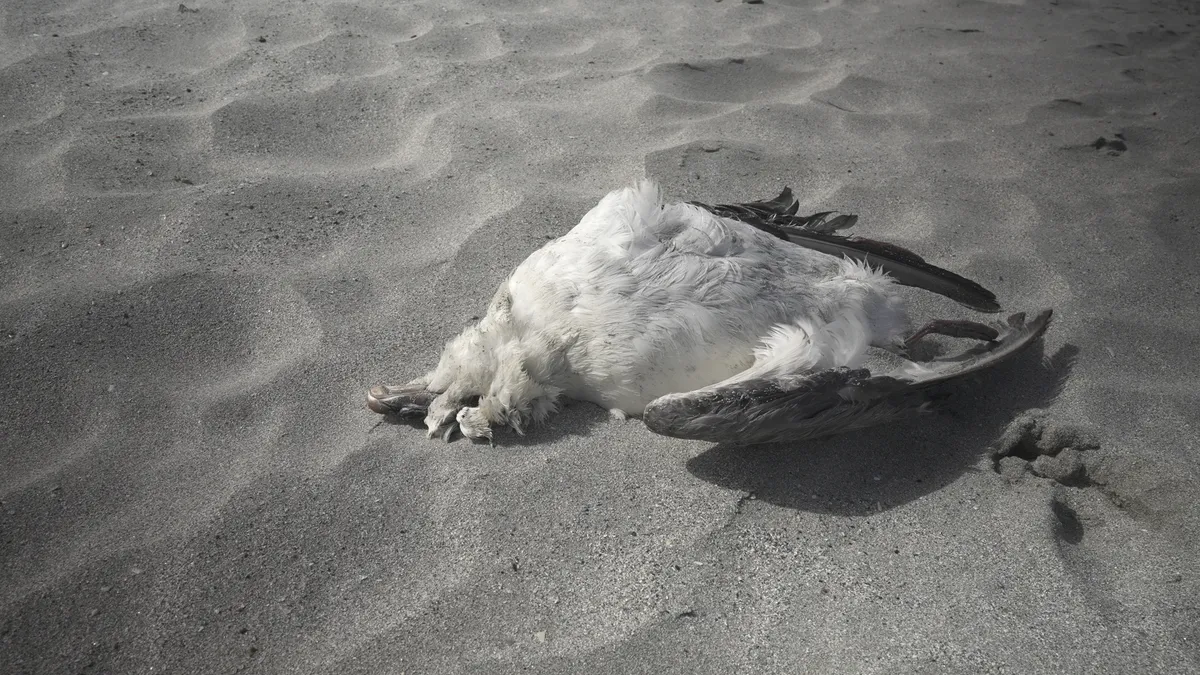One of the worst outbreaks of avian influenza ever recorded in the UK is currently sweeping through wild bird populations, with huge numbers of birds suffering and dying from the disease.
The bird flu causing these birds to die is a highly mutable and deadly new form that originated in poultry farming.
Content warning: This article contains image of dead birds.
What is bird flu?
Avian influenza, commonly known as bird flu, is a contagious viral disease affecting the respiratory, digestive and/or nervous systems of many species of birds.
There are many different forms of the disease, and while it mainly affects birds, it can on occasion also affect humans and other mammals.
What are the symptoms of bird flu?
There are many different symptoms, including neurological issues such as loss of coordination, moving in circles, and body or head trembling. A comprehensive list can be found on the UK government website.

Bird flu is passed from animal to animal through contact with infected saliva, nasal secretions or faeces. Wild birds, including waterfowl, are often more resistant to bird flu than domestic birds and can carry and transmit the virus without showing evidence of disease, so when they migrate they can spread the virus even further. Moving poultry such as chickens around and between countries is also known to be a major cause of the spread the virus.
There are many forms of the virus, not all of them fatal, but the strain known as highly pathogenic avian influenza (HPAI) is the most serious type of bird flu and is often fatal in birds.
Related content:
How to report dead birds and potential bird flu victims
If you come across a single dead wild waterfowl (ie swan, goose or duck), a single dead bird of prey, or five or more dead wild birds of any other species (including gulls) at the same place, please report them to the Defra helpline 03459 335577 or in Northern Ireland to DAERA on 0300 200 7840.
Which birds have been affected by bird flu?
A huge number of species have been affected by bird flu this year, including many species of wildfowl, seabirds such as gannets and fulmars, gulls, birds of prey such as sea eagles, buzzards, kestrels, peregrines, as well as other smaller or more randomised incidents, eg a tawny owl and pied wagtail.
On Shetland, birds affected include eider ducks, gannets, bonxies (great skua) and gulls, and the bird flu outbreak at RSPB Minsmere has included black-headed gulls, common terns, Sandwich terns and one kittiwake.

Defra have a list of bird species that have tested positive, but we do not at this stage have a full picture of the impact on wild birds as not all dead wild birds will have been tested, or even reported.
There have also been reports of avian flu occurring in other parts of the world – cranes in Israel being affected over the winter, for example, and North America having had an outbreak of the Eurasian HPAI strain.
Why is bird flu such a problem for wild birds?
Bird flu is hitting many birds that are already struggling. Seabirds, for example, are already under massive pressure from the climate crisis, declining numbers of fish, entanglement in fishing gear and development along our shores. Seabirds also tend to take longer to reach breeding age and have fewer chicks, meaning that it will take much longer for their numbers to build back up after bird flu.
And the impact of the virus on a group can be staggering. Last year alone, one third of the Svalbard barnacle geese that spend their winter around the Solway estuary were lost to bird flu.
This also has international implications because Britain has a globally important number of seabirds. The UK, for example, is home to 56% of the world’s amber-listed gannet population, and Scotland has 60% of the world’s amber-listed great skuas.
Does bird flu affect domestic birds?
Domestic birds can be affected, and the poultry industry was hit hard by bird flu in the past year. As of May 30th, there have been 119 outbreaks since 26 October 2021 on premises with captive birds, poultry, etc.
This is now the largest ever UK outbreak of bird flu. As of May 30th, there have been 119 outbreaks since October 2021 on premises with captive birds and poultry. Prior to this, the largest number was 26 cases in 2020/2021 and 13 cases in 2016/2017.
Defra have strong biosecurity measures they put in place including Protection Zones and Surveillance Zones around infected premises.
Can bird flu infect people?
Very few strains of bird flu have been recorded as infecting humans, and the risk to public health is usually extremely low (the virus does not easily infect humans, and then it is not easily transmitted from person to person).
Where there have been cases of humans catching bird flu, most of them have come from close contact with infected domestic poultry.
We would therefore strongly urge everyone not to touch any sick or dead birds, their droppings, or any water nearby, and in order to best protect your dogs, do not let them approach any sick or dead birds, ideally by keeping them on a lead whilst walking.
Main image: A pair of gannets at Great Saltee Island, Republic of Ireland. © Ben Andrew/RSPB
